Comprehensive Resource Allocation and Management Report
VerifiedAdded on 2023/04/22
|10
|2630
|429
Report
AI Summary
This report provides a comprehensive overview of resource allocation, a critical aspect of business management. It begins by defining resources, both tangible and intangible, and emphasizes the importance of a well-defined resource plan for maximizing benefits and minimizing costs. The report delves into the process of resource allocation, including understanding project scope, identifying risks, and tracking deliverables. It highlights the significance of cost management and outlines key principles for achieving cost-effectiveness. The report then explores the process of resource planning, including identification, documentation, and development of a planning structure. It also discusses resource requirements, the need for purchasing resources, and the creation of a resource plan/budget. Finally, the report examines controlling measures, including defining scope, identifying risks, and evaluating the business cycle, along with the importance of control mechanisms throughout the project lifecycle, administrative controls, and the maintenance of assets. The report emphasizes the importance of monitoring, evaluation, and adaptation to ensure the efficient and effective use of resources to achieve organizational goals.

0
RUNNING HEAD: RESOURCE ALLOCATION
Resource
Allocation
System04115
RUNNING HEAD: RESOURCE ALLOCATION
Resource
Allocation
System04115
Paraphrase This Document
Need a fresh take? Get an instant paraphrase of this document with our AI Paraphraser
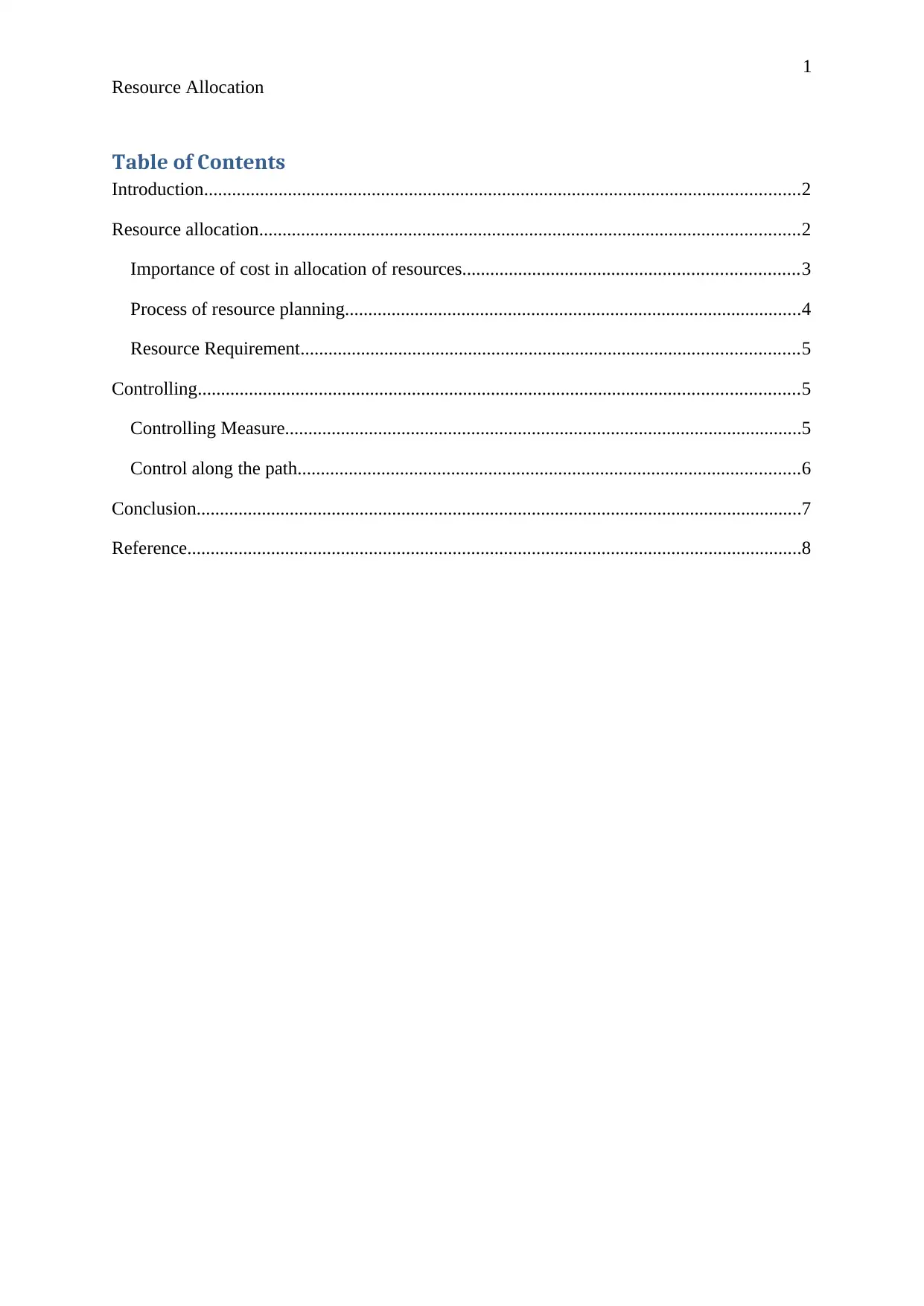
1
Resource Allocation
Table of Contents
Introduction................................................................................................................................2
Resource allocation....................................................................................................................2
Importance of cost in allocation of resources........................................................................3
Process of resource planning..................................................................................................4
Resource Requirement...........................................................................................................5
Controlling.................................................................................................................................5
Controlling Measure...............................................................................................................5
Control along the path............................................................................................................6
Conclusion..................................................................................................................................7
Reference....................................................................................................................................8
Resource Allocation
Table of Contents
Introduction................................................................................................................................2
Resource allocation....................................................................................................................2
Importance of cost in allocation of resources........................................................................3
Process of resource planning..................................................................................................4
Resource Requirement...........................................................................................................5
Controlling.................................................................................................................................5
Controlling Measure...............................................................................................................5
Control along the path............................................................................................................6
Conclusion..................................................................................................................................7
Reference....................................................................................................................................8
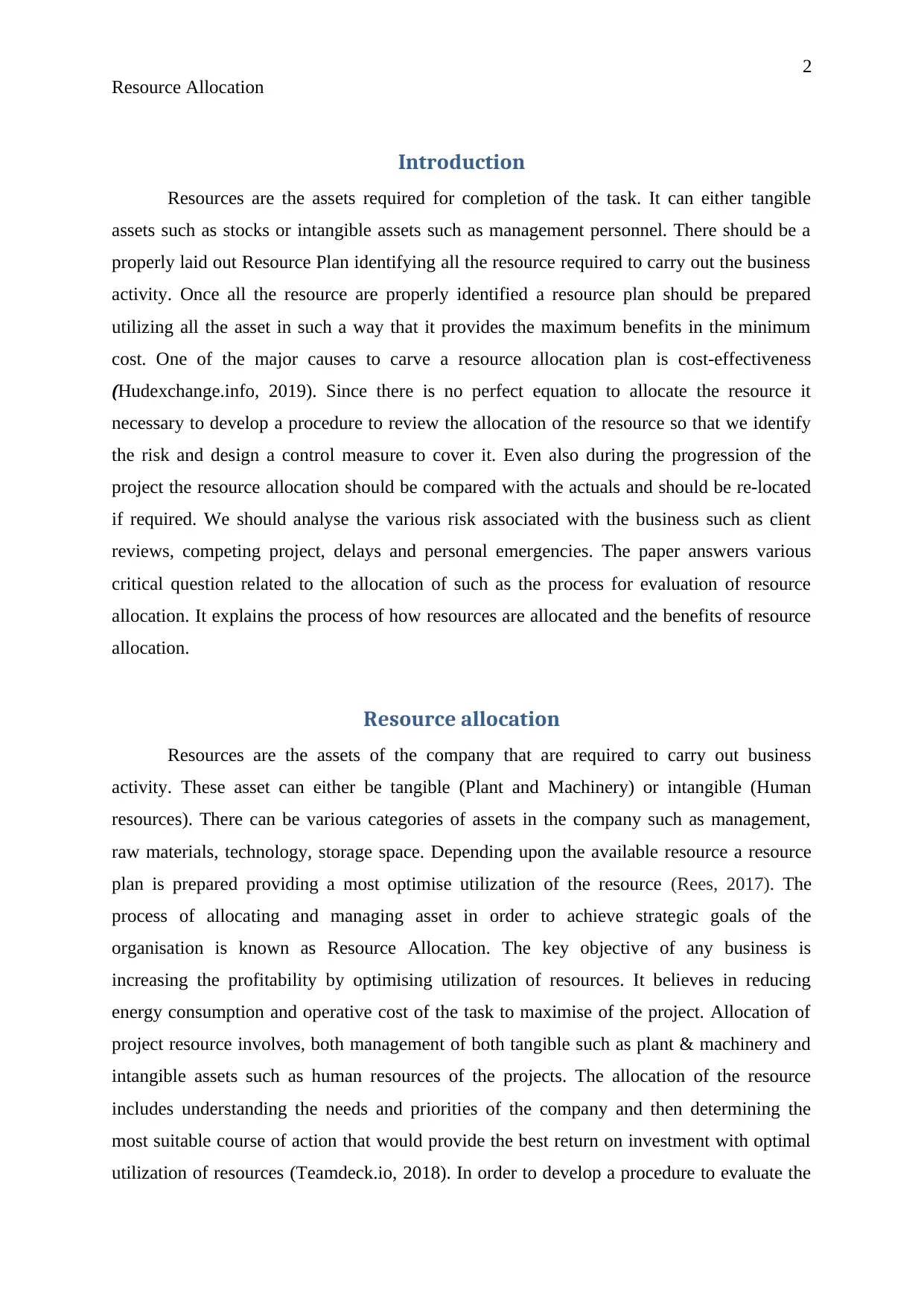
2
Resource Allocation
Introduction
Resources are the assets required for completion of the task. It can either tangible
assets such as stocks or intangible assets such as management personnel. There should be a
properly laid out Resource Plan identifying all the resource required to carry out the business
activity. Once all the resource are properly identified a resource plan should be prepared
utilizing all the asset in such a way that it provides the maximum benefits in the minimum
cost. One of the major causes to carve a resource allocation plan is cost-effectiveness
(Hudexchange.info, 2019). Since there is no perfect equation to allocate the resource it
necessary to develop a procedure to review the allocation of the resource so that we identify
the risk and design a control measure to cover it. Even also during the progression of the
project the resource allocation should be compared with the actuals and should be re-located
if required. We should analyse the various risk associated with the business such as client
reviews, competing project, delays and personal emergencies. The paper answers various
critical question related to the allocation of such as the process for evaluation of resource
allocation. It explains the process of how resources are allocated and the benefits of resource
allocation.
Resource allocation
Resources are the assets of the company that are required to carry out business
activity. These asset can either be tangible (Plant and Machinery) or intangible (Human
resources). There can be various categories of assets in the company such as management,
raw materials, technology, storage space. Depending upon the available resource a resource
plan is prepared providing a most optimise utilization of the resource (Rees, 2017). The
process of allocating and managing asset in order to achieve strategic goals of the
organisation is known as Resource Allocation. The key objective of any business is
increasing the profitability by optimising utilization of resources. It believes in reducing
energy consumption and operative cost of the task to maximise of the project. Allocation of
project resource involves, both management of both tangible such as plant & machinery and
intangible assets such as human resources of the projects. The allocation of the resource
includes understanding the needs and priorities of the company and then determining the
most suitable course of action that would provide the best return on investment with optimal
utilization of resources (Teamdeck.io, 2018). In order to develop a procedure to evaluate the
Resource Allocation
Introduction
Resources are the assets required for completion of the task. It can either tangible
assets such as stocks or intangible assets such as management personnel. There should be a
properly laid out Resource Plan identifying all the resource required to carry out the business
activity. Once all the resource are properly identified a resource plan should be prepared
utilizing all the asset in such a way that it provides the maximum benefits in the minimum
cost. One of the major causes to carve a resource allocation plan is cost-effectiveness
(Hudexchange.info, 2019). Since there is no perfect equation to allocate the resource it
necessary to develop a procedure to review the allocation of the resource so that we identify
the risk and design a control measure to cover it. Even also during the progression of the
project the resource allocation should be compared with the actuals and should be re-located
if required. We should analyse the various risk associated with the business such as client
reviews, competing project, delays and personal emergencies. The paper answers various
critical question related to the allocation of such as the process for evaluation of resource
allocation. It explains the process of how resources are allocated and the benefits of resource
allocation.
Resource allocation
Resources are the assets of the company that are required to carry out business
activity. These asset can either be tangible (Plant and Machinery) or intangible (Human
resources). There can be various categories of assets in the company such as management,
raw materials, technology, storage space. Depending upon the available resource a resource
plan is prepared providing a most optimise utilization of the resource (Rees, 2017). The
process of allocating and managing asset in order to achieve strategic goals of the
organisation is known as Resource Allocation. The key objective of any business is
increasing the profitability by optimising utilization of resources. It believes in reducing
energy consumption and operative cost of the task to maximise of the project. Allocation of
project resource involves, both management of both tangible such as plant & machinery and
intangible assets such as human resources of the projects. The allocation of the resource
includes understanding the needs and priorities of the company and then determining the
most suitable course of action that would provide the best return on investment with optimal
utilization of resources (Teamdeck.io, 2018). In order to develop a procedure to evaluate the
⊘ This is a preview!⊘
Do you want full access?
Subscribe today to unlock all pages.

Trusted by 1+ million students worldwide
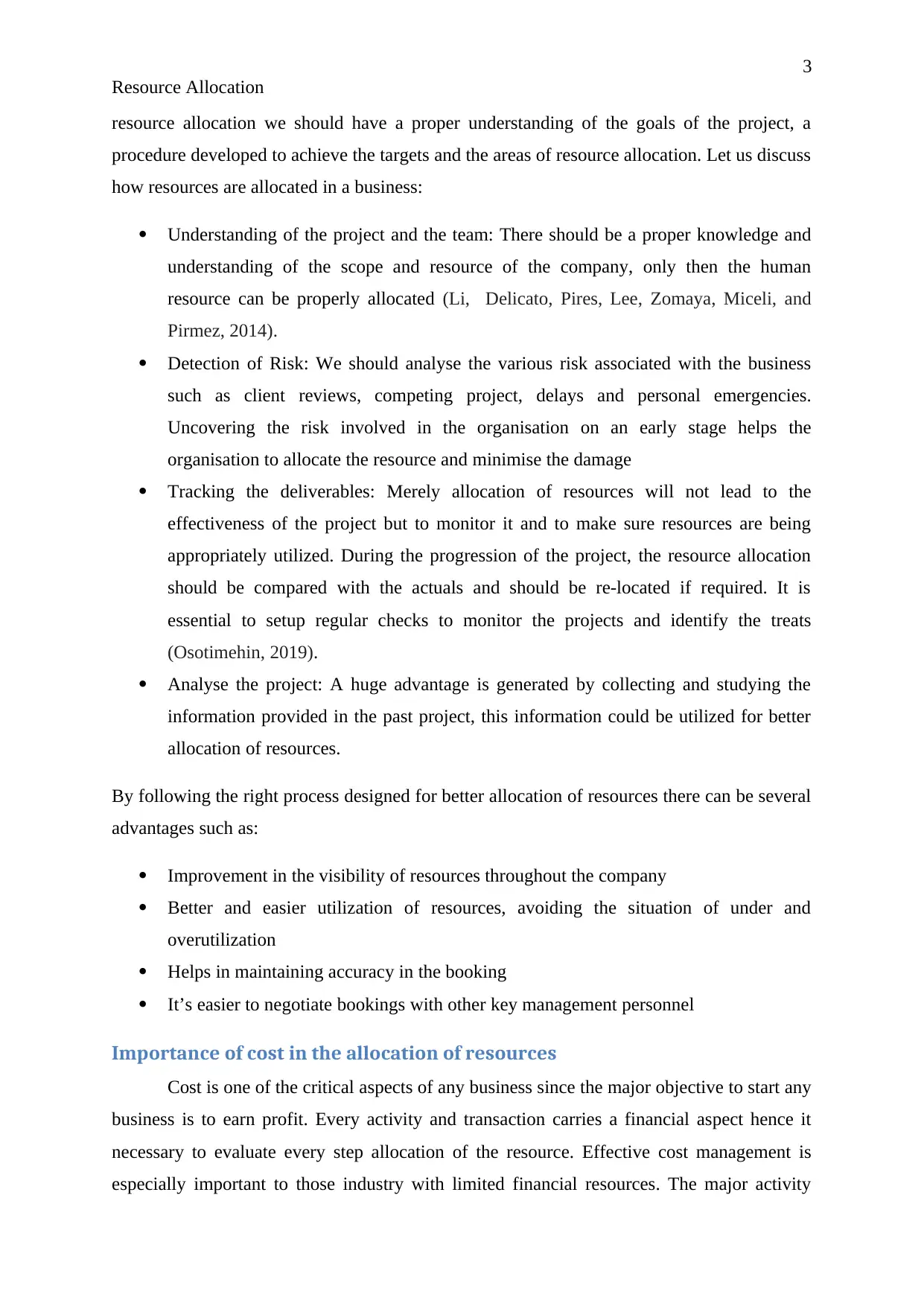
3
Resource Allocation
resource allocation we should have a proper understanding of the goals of the project, a
procedure developed to achieve the targets and the areas of resource allocation. Let us discuss
how resources are allocated in a business:
Understanding of the project and the team: There should be a proper knowledge and
understanding of the scope and resource of the company, only then the human
resource can be properly allocated (Li, Delicato, Pires, Lee, Zomaya, Miceli, and
Pirmez, 2014).
Detection of Risk: We should analyse the various risk associated with the business
such as client reviews, competing project, delays and personal emergencies.
Uncovering the risk involved in the organisation on an early stage helps the
organisation to allocate the resource and minimise the damage
Tracking the deliverables: Merely allocation of resources will not lead to the
effectiveness of the project but to monitor it and to make sure resources are being
appropriately utilized. During the progression of the project, the resource allocation
should be compared with the actuals and should be re-located if required. It is
essential to setup regular checks to monitor the projects and identify the treats
(Osotimehin, 2019).
Analyse the project: A huge advantage is generated by collecting and studying the
information provided in the past project, this information could be utilized for better
allocation of resources.
By following the right process designed for better allocation of resources there can be several
advantages such as:
Improvement in the visibility of resources throughout the company
Better and easier utilization of resources, avoiding the situation of under and
overutilization
Helps in maintaining accuracy in the booking
It’s easier to negotiate bookings with other key management personnel
Importance of cost in the allocation of resources
Cost is one of the critical aspects of any business since the major objective to start any
business is to earn profit. Every activity and transaction carries a financial aspect hence it
necessary to evaluate every step allocation of the resource. Effective cost management is
especially important to those industry with limited financial resources. The major activity
Resource Allocation
resource allocation we should have a proper understanding of the goals of the project, a
procedure developed to achieve the targets and the areas of resource allocation. Let us discuss
how resources are allocated in a business:
Understanding of the project and the team: There should be a proper knowledge and
understanding of the scope and resource of the company, only then the human
resource can be properly allocated (Li, Delicato, Pires, Lee, Zomaya, Miceli, and
Pirmez, 2014).
Detection of Risk: We should analyse the various risk associated with the business
such as client reviews, competing project, delays and personal emergencies.
Uncovering the risk involved in the organisation on an early stage helps the
organisation to allocate the resource and minimise the damage
Tracking the deliverables: Merely allocation of resources will not lead to the
effectiveness of the project but to monitor it and to make sure resources are being
appropriately utilized. During the progression of the project, the resource allocation
should be compared with the actuals and should be re-located if required. It is
essential to setup regular checks to monitor the projects and identify the treats
(Osotimehin, 2019).
Analyse the project: A huge advantage is generated by collecting and studying the
information provided in the past project, this information could be utilized for better
allocation of resources.
By following the right process designed for better allocation of resources there can be several
advantages such as:
Improvement in the visibility of resources throughout the company
Better and easier utilization of resources, avoiding the situation of under and
overutilization
Helps in maintaining accuracy in the booking
It’s easier to negotiate bookings with other key management personnel
Importance of cost in the allocation of resources
Cost is one of the critical aspects of any business since the major objective to start any
business is to earn profit. Every activity and transaction carries a financial aspect hence it
necessary to evaluate every step allocation of the resource. Effective cost management is
especially important to those industry with limited financial resources. The major activity
Paraphrase This Document
Need a fresh take? Get an instant paraphrase of this document with our AI Paraphraser
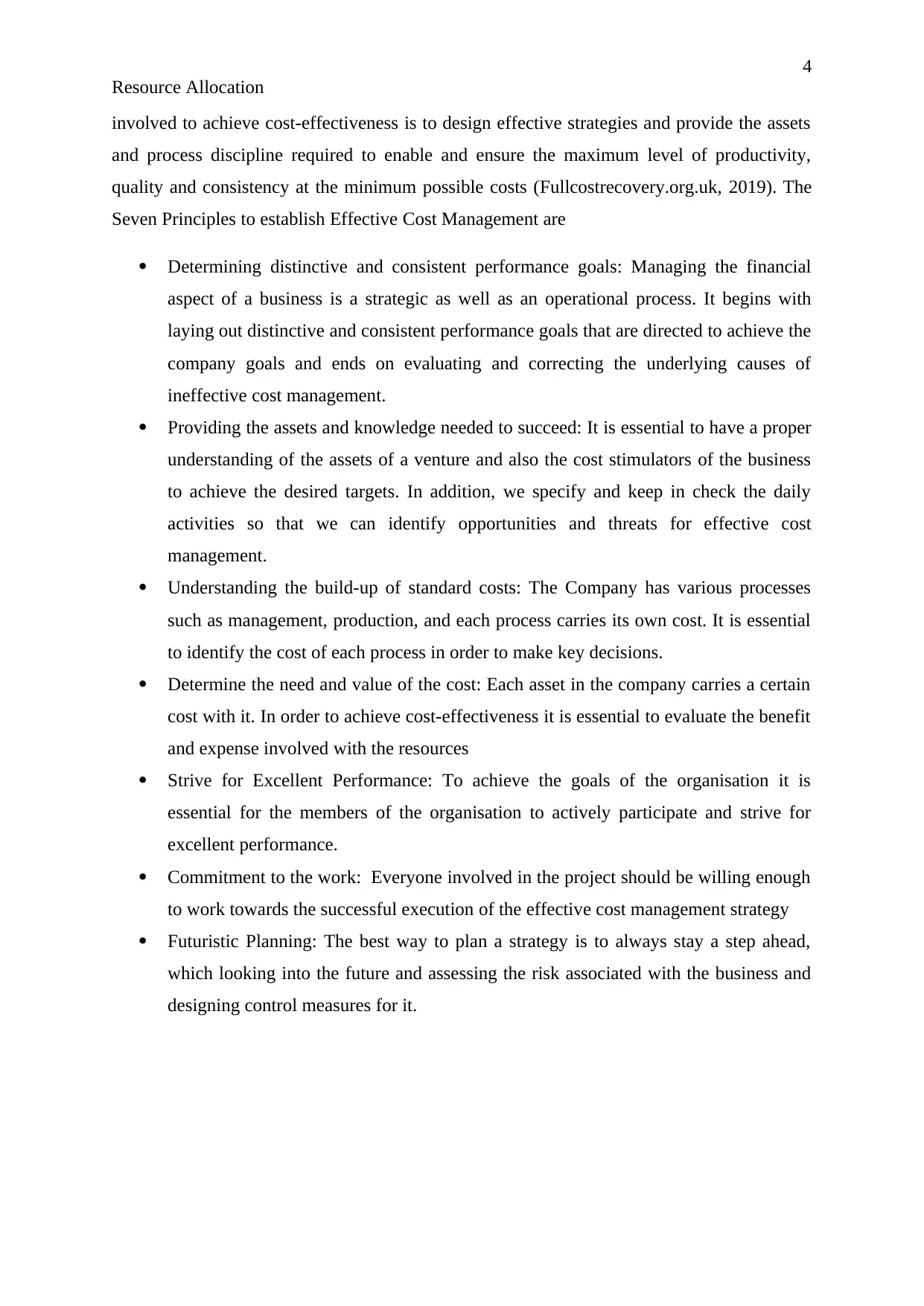
4
Resource Allocation
involved to achieve cost-effectiveness is to design effective strategies and provide the assets
and process discipline required to enable and ensure the maximum level of productivity,
quality and consistency at the minimum possible costs (Fullcostrecovery.org.uk, 2019). The
Seven Principles to establish Effective Cost Management are
Determining distinctive and consistent performance goals: Managing the financial
aspect of a business is a strategic as well as an operational process. It begins with
laying out distinctive and consistent performance goals that are directed to achieve the
company goals and ends on evaluating and correcting the underlying causes of
ineffective cost management.
Providing the assets and knowledge needed to succeed: It is essential to have a proper
understanding of the assets of a venture and also the cost stimulators of the business
to achieve the desired targets. In addition, we specify and keep in check the daily
activities so that we can identify opportunities and threats for effective cost
management.
Understanding the build-up of standard costs: The Company has various processes
such as management, production, and each process carries its own cost. It is essential
to identify the cost of each process in order to make key decisions.
Determine the need and value of the cost: Each asset in the company carries a certain
cost with it. In order to achieve cost-effectiveness it is essential to evaluate the benefit
and expense involved with the resources
Strive for Excellent Performance: To achieve the goals of the organisation it is
essential for the members of the organisation to actively participate and strive for
excellent performance.
Commitment to the work: Everyone involved in the project should be willing enough
to work towards the successful execution of the effective cost management strategy
Futuristic Planning: The best way to plan a strategy is to always stay a step ahead,
which looking into the future and assessing the risk associated with the business and
designing control measures for it.
Resource Allocation
involved to achieve cost-effectiveness is to design effective strategies and provide the assets
and process discipline required to enable and ensure the maximum level of productivity,
quality and consistency at the minimum possible costs (Fullcostrecovery.org.uk, 2019). The
Seven Principles to establish Effective Cost Management are
Determining distinctive and consistent performance goals: Managing the financial
aspect of a business is a strategic as well as an operational process. It begins with
laying out distinctive and consistent performance goals that are directed to achieve the
company goals and ends on evaluating and correcting the underlying causes of
ineffective cost management.
Providing the assets and knowledge needed to succeed: It is essential to have a proper
understanding of the assets of a venture and also the cost stimulators of the business
to achieve the desired targets. In addition, we specify and keep in check the daily
activities so that we can identify opportunities and threats for effective cost
management.
Understanding the build-up of standard costs: The Company has various processes
such as management, production, and each process carries its own cost. It is essential
to identify the cost of each process in order to make key decisions.
Determine the need and value of the cost: Each asset in the company carries a certain
cost with it. In order to achieve cost-effectiveness it is essential to evaluate the benefit
and expense involved with the resources
Strive for Excellent Performance: To achieve the goals of the organisation it is
essential for the members of the organisation to actively participate and strive for
excellent performance.
Commitment to the work: Everyone involved in the project should be willing enough
to work towards the successful execution of the effective cost management strategy
Futuristic Planning: The best way to plan a strategy is to always stay a step ahead,
which looking into the future and assessing the risk associated with the business and
designing control measures for it.
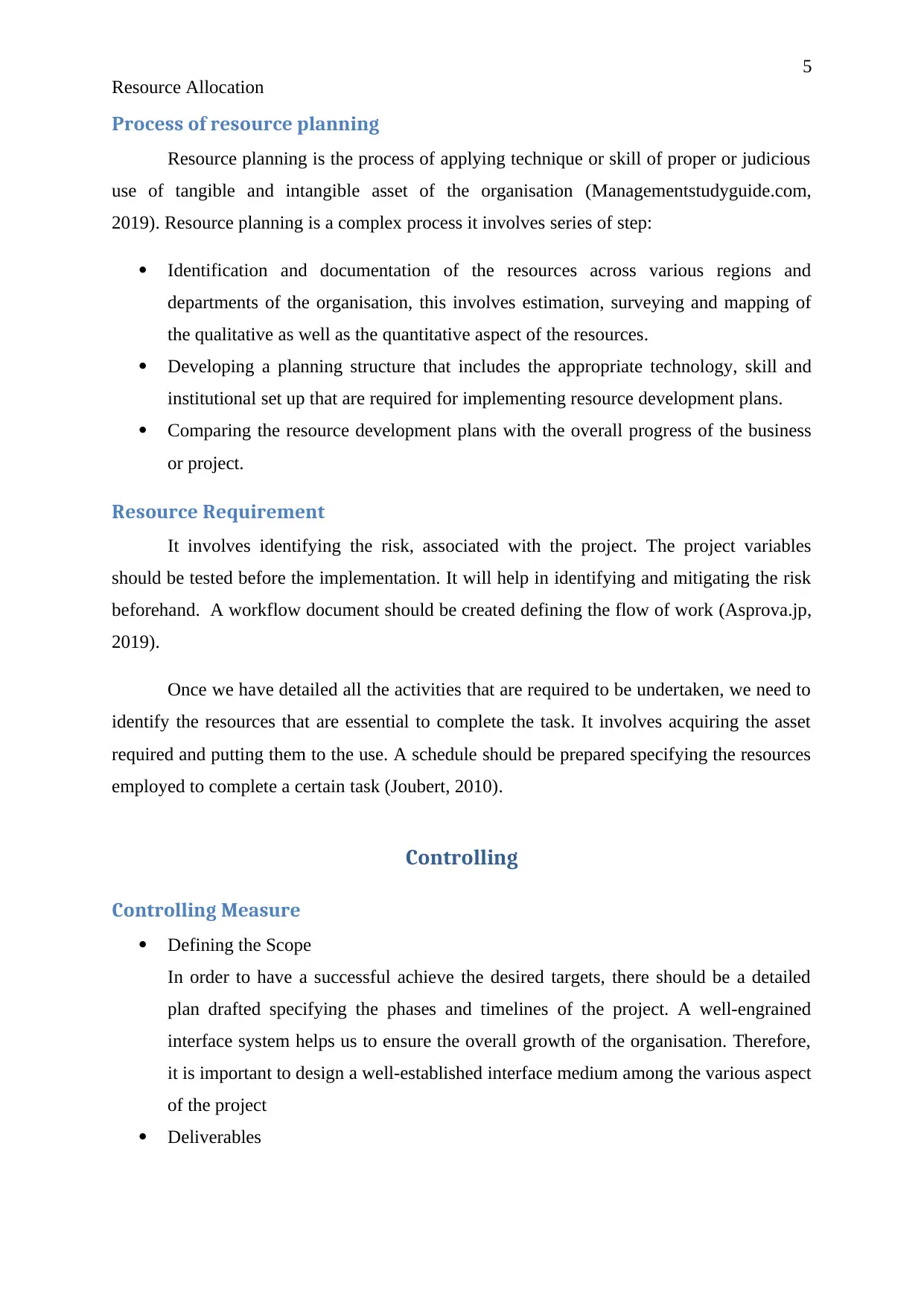
5
Resource Allocation
Process of resource planning
Resource planning is the process of applying technique or skill of proper or judicious
use of tangible and intangible asset of the organisation (Managementstudyguide.com,
2019). Resource planning is a complex process it involves series of step:
Identification and documentation of the resources across various regions and
departments of the organisation, this involves estimation, surveying and mapping of
the qualitative as well as the quantitative aspect of the resources.
Developing a planning structure that includes the appropriate technology, skill and
institutional set up that are required for implementing resource development plans.
Comparing the resource development plans with the overall progress of the business
or project.
Resource Requirement
It involves identifying the risk, associated with the project. The project variables
should be tested before the implementation. It will help in identifying and mitigating the risk
beforehand. A workflow document should be created defining the flow of work (Asprova.jp,
2019).
Once we have detailed all the activities that are required to be undertaken, we need to
identify the resources that are essential to complete the task. It involves acquiring the asset
required and putting them to the use. A schedule should be prepared specifying the resources
employed to complete a certain task (Joubert, 2010).
Controlling
Controlling Measure
Defining the Scope
In order to have a successful achieve the desired targets, there should be a detailed
plan drafted specifying the phases and timelines of the project. A well-engrained
interface system helps us to ensure the overall growth of the organisation. Therefore,
it is important to design a well-established interface medium among the various aspect
of the project
Deliverables
Resource Allocation
Process of resource planning
Resource planning is the process of applying technique or skill of proper or judicious
use of tangible and intangible asset of the organisation (Managementstudyguide.com,
2019). Resource planning is a complex process it involves series of step:
Identification and documentation of the resources across various regions and
departments of the organisation, this involves estimation, surveying and mapping of
the qualitative as well as the quantitative aspect of the resources.
Developing a planning structure that includes the appropriate technology, skill and
institutional set up that are required for implementing resource development plans.
Comparing the resource development plans with the overall progress of the business
or project.
Resource Requirement
It involves identifying the risk, associated with the project. The project variables
should be tested before the implementation. It will help in identifying and mitigating the risk
beforehand. A workflow document should be created defining the flow of work (Asprova.jp,
2019).
Once we have detailed all the activities that are required to be undertaken, we need to
identify the resources that are essential to complete the task. It involves acquiring the asset
required and putting them to the use. A schedule should be prepared specifying the resources
employed to complete a certain task (Joubert, 2010).
Controlling
Controlling Measure
Defining the Scope
In order to have a successful achieve the desired targets, there should be a detailed
plan drafted specifying the phases and timelines of the project. A well-engrained
interface system helps us to ensure the overall growth of the organisation. Therefore,
it is important to design a well-established interface medium among the various aspect
of the project
Deliverables
⊘ This is a preview!⊘
Do you want full access?
Subscribe today to unlock all pages.

Trusted by 1+ million students worldwide
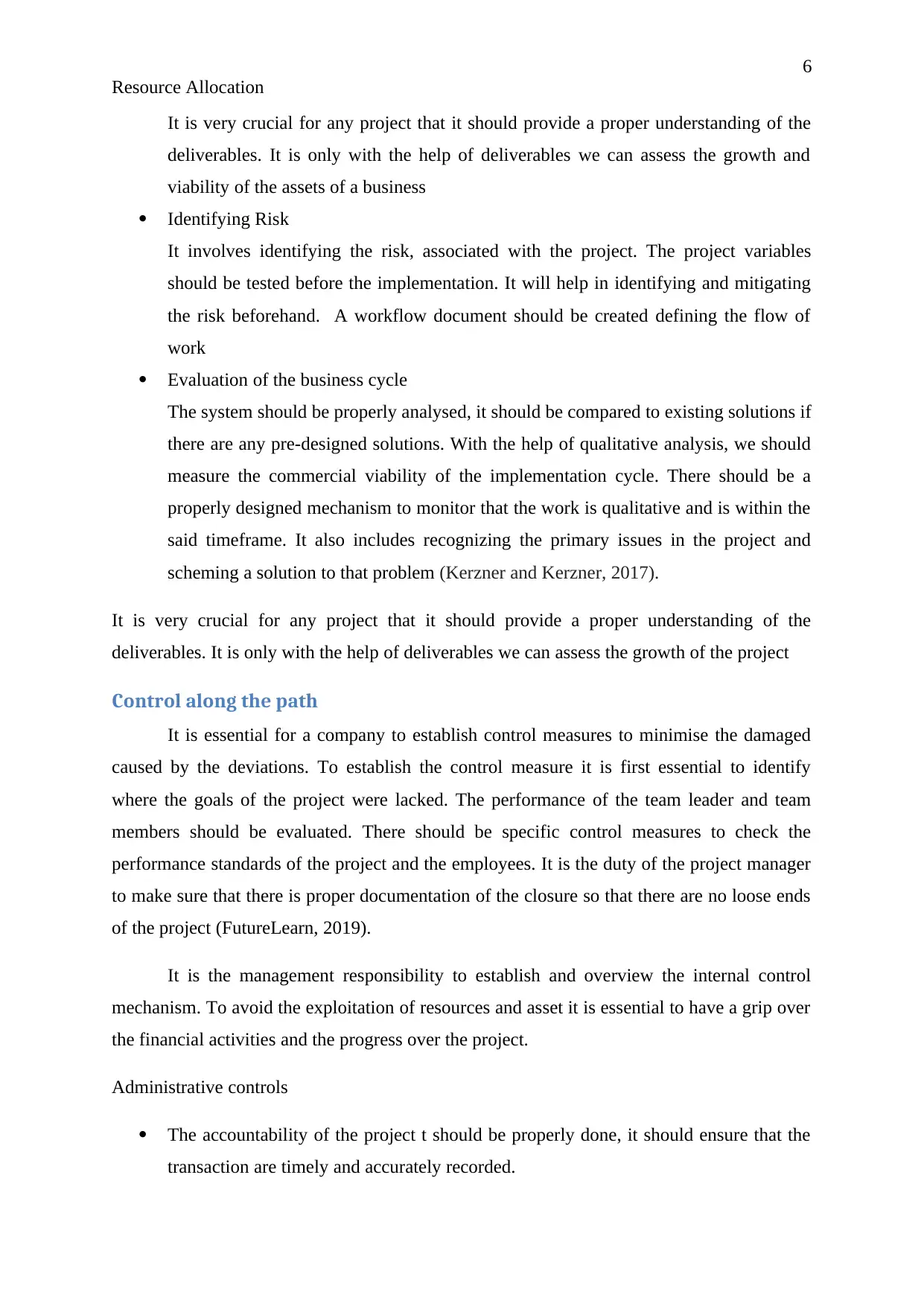
6
Resource Allocation
It is very crucial for any project that it should provide a proper understanding of the
deliverables. It is only with the help of deliverables we can assess the growth and
viability of the assets of a business
Identifying Risk
It involves identifying the risk, associated with the project. The project variables
should be tested before the implementation. It will help in identifying and mitigating
the risk beforehand. A workflow document should be created defining the flow of
work
Evaluation of the business cycle
The system should be properly analysed, it should be compared to existing solutions if
there are any pre-designed solutions. With the help of qualitative analysis, we should
measure the commercial viability of the implementation cycle. There should be a
properly designed mechanism to monitor that the work is qualitative and is within the
said timeframe. It also includes recognizing the primary issues in the project and
scheming a solution to that problem (Kerzner and Kerzner, 2017).
It is very crucial for any project that it should provide a proper understanding of the
deliverables. It is only with the help of deliverables we can assess the growth of the project
Control along the path
It is essential for a company to establish control measures to minimise the damaged
caused by the deviations. To establish the control measure it is first essential to identify
where the goals of the project were lacked. The performance of the team leader and team
members should be evaluated. There should be specific control measures to check the
performance standards of the project and the employees. It is the duty of the project manager
to make sure that there is proper documentation of the closure so that there are no loose ends
of the project (FutureLearn, 2019).
It is the management responsibility to establish and overview the internal control
mechanism. To avoid the exploitation of resources and asset it is essential to have a grip over
the financial activities and the progress over the project.
Administrative controls
The accountability of the project t should be properly done, it should ensure that the
transaction are timely and accurately recorded.
Resource Allocation
It is very crucial for any project that it should provide a proper understanding of the
deliverables. It is only with the help of deliverables we can assess the growth and
viability of the assets of a business
Identifying Risk
It involves identifying the risk, associated with the project. The project variables
should be tested before the implementation. It will help in identifying and mitigating
the risk beforehand. A workflow document should be created defining the flow of
work
Evaluation of the business cycle
The system should be properly analysed, it should be compared to existing solutions if
there are any pre-designed solutions. With the help of qualitative analysis, we should
measure the commercial viability of the implementation cycle. There should be a
properly designed mechanism to monitor that the work is qualitative and is within the
said timeframe. It also includes recognizing the primary issues in the project and
scheming a solution to that problem (Kerzner and Kerzner, 2017).
It is very crucial for any project that it should provide a proper understanding of the
deliverables. It is only with the help of deliverables we can assess the growth of the project
Control along the path
It is essential for a company to establish control measures to minimise the damaged
caused by the deviations. To establish the control measure it is first essential to identify
where the goals of the project were lacked. The performance of the team leader and team
members should be evaluated. There should be specific control measures to check the
performance standards of the project and the employees. It is the duty of the project manager
to make sure that there is proper documentation of the closure so that there are no loose ends
of the project (FutureLearn, 2019).
It is the management responsibility to establish and overview the internal control
mechanism. To avoid the exploitation of resources and asset it is essential to have a grip over
the financial activities and the progress over the project.
Administrative controls
The accountability of the project t should be properly done, it should ensure that the
transaction are timely and accurately recorded.
Paraphrase This Document
Need a fresh take? Get an instant paraphrase of this document with our AI Paraphraser
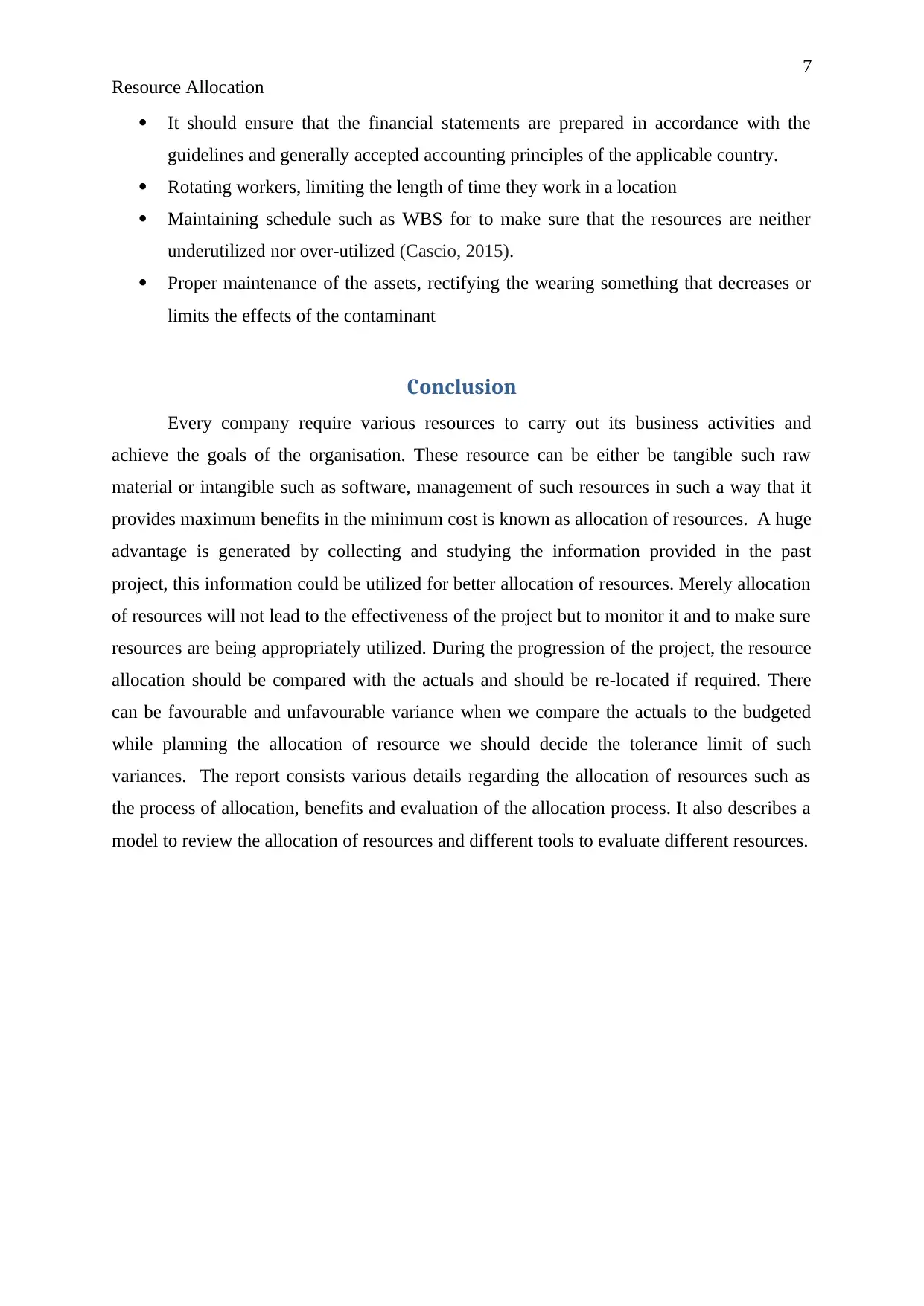
7
Resource Allocation
It should ensure that the financial statements are prepared in accordance with the
guidelines and generally accepted accounting principles of the applicable country.
Rotating workers, limiting the length of time they work in a location
Maintaining schedule such as WBS for to make sure that the resources are neither
underutilized nor over-utilized (Cascio, 2015).
Proper maintenance of the assets, rectifying the wearing something that decreases or
limits the effects of the contaminant
Conclusion
Every company require various resources to carry out its business activities and
achieve the goals of the organisation. These resource can be either be tangible such raw
material or intangible such as software, management of such resources in such a way that it
provides maximum benefits in the minimum cost is known as allocation of resources. A huge
advantage is generated by collecting and studying the information provided in the past
project, this information could be utilized for better allocation of resources. Merely allocation
of resources will not lead to the effectiveness of the project but to monitor it and to make sure
resources are being appropriately utilized. During the progression of the project, the resource
allocation should be compared with the actuals and should be re-located if required. There
can be favourable and unfavourable variance when we compare the actuals to the budgeted
while planning the allocation of resource we should decide the tolerance limit of such
variances. The report consists various details regarding the allocation of resources such as
the process of allocation, benefits and evaluation of the allocation process. It also describes a
model to review the allocation of resources and different tools to evaluate different resources.
Resource Allocation
It should ensure that the financial statements are prepared in accordance with the
guidelines and generally accepted accounting principles of the applicable country.
Rotating workers, limiting the length of time they work in a location
Maintaining schedule such as WBS for to make sure that the resources are neither
underutilized nor over-utilized (Cascio, 2015).
Proper maintenance of the assets, rectifying the wearing something that decreases or
limits the effects of the contaminant
Conclusion
Every company require various resources to carry out its business activities and
achieve the goals of the organisation. These resource can be either be tangible such raw
material or intangible such as software, management of such resources in such a way that it
provides maximum benefits in the minimum cost is known as allocation of resources. A huge
advantage is generated by collecting and studying the information provided in the past
project, this information could be utilized for better allocation of resources. Merely allocation
of resources will not lead to the effectiveness of the project but to monitor it and to make sure
resources are being appropriately utilized. During the progression of the project, the resource
allocation should be compared with the actuals and should be re-located if required. There
can be favourable and unfavourable variance when we compare the actuals to the budgeted
while planning the allocation of resource we should decide the tolerance limit of such
variances. The report consists various details regarding the allocation of resources such as
the process of allocation, benefits and evaluation of the allocation process. It also describes a
model to review the allocation of resources and different tools to evaluate different resources.
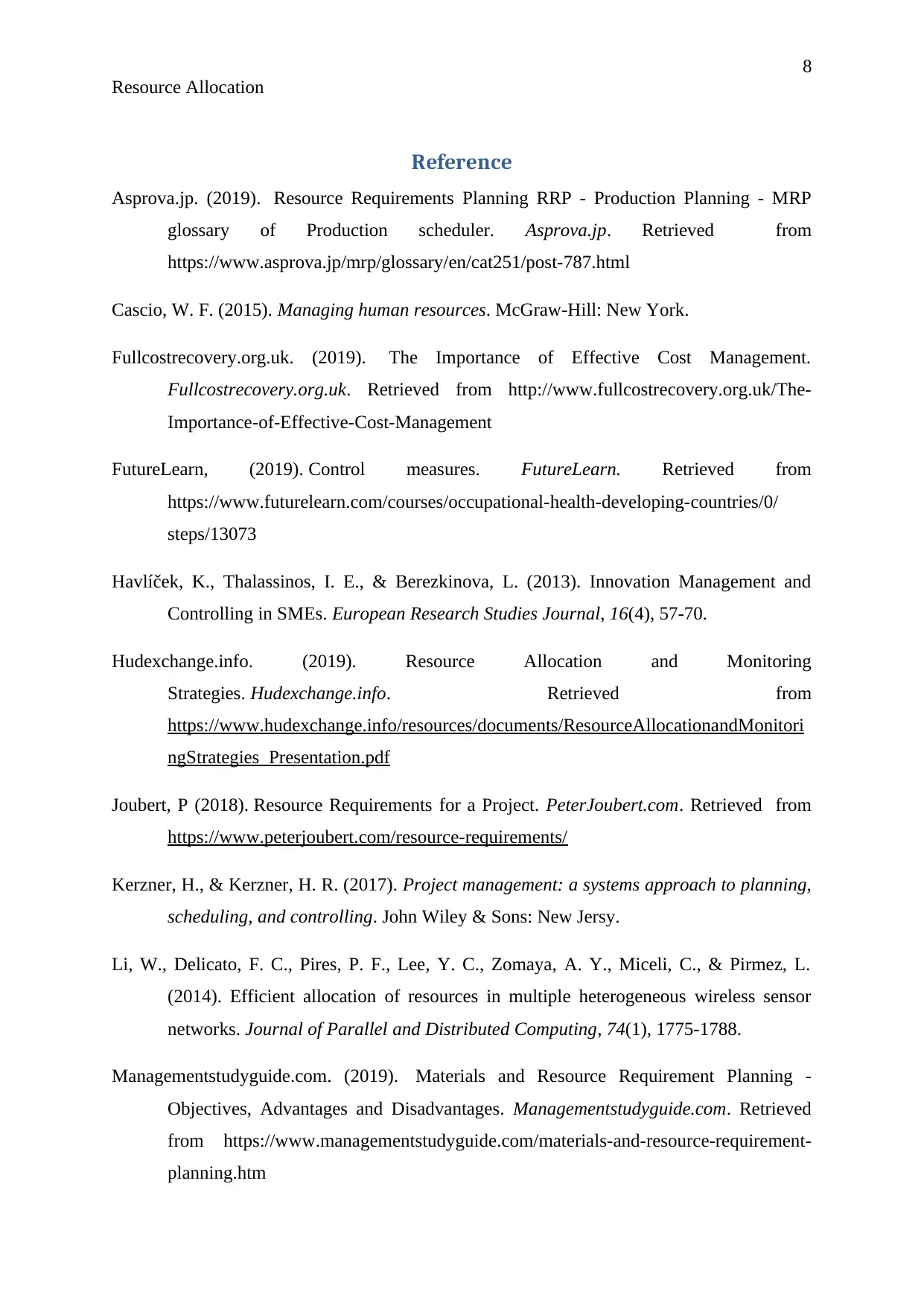
8
Resource Allocation
Reference
Asprova.jp. (2019). Resource Requirements Planning RRP - Production Planning - MRP
glossary of Production scheduler. Asprova.jp. Retrieved from
https://www.asprova.jp/mrp/glossary/en/cat251/post-787.html
Cascio, W. F. (2015). Managing human resources. McGraw-Hill: New York.
Fullcostrecovery.org.uk. (2019). The Importance of Effective Cost Management.
Fullcostrecovery.org.uk. Retrieved from http://www.fullcostrecovery.org.uk/The-
Importance-of-Effective-Cost-Management
FutureLearn, (2019). Control measures. FutureLearn. Retrieved from
https://www.futurelearn.com/courses/occupational-health-developing-countries/0/
steps/13073
Havlíček, K., Thalassinos, I. E., & Berezkinova, L. (2013). Innovation Management and
Controlling in SMEs. European Research Studies Journal, 16(4), 57-70.
Hudexchange.info. (2019). Resource Allocation and Monitoring
Strategies. Hudexchange.info. Retrieved from
https://www.hudexchange.info/resources/documents/ResourceAllocationandMonitori
ngStrategies_Presentation.pdf
Joubert, P (2018). Resource Requirements for a Project. PeterJoubert.com. Retrieved from
https://www.peterjoubert.com/resource-requirements/
Kerzner, H., & Kerzner, H. R. (2017). Project management: a systems approach to planning,
scheduling, and controlling. John Wiley & Sons: New Jersy.
Li, W., Delicato, F. C., Pires, P. F., Lee, Y. C., Zomaya, A. Y., Miceli, C., & Pirmez, L.
(2014). Efficient allocation of resources in multiple heterogeneous wireless sensor
networks. Journal of Parallel and Distributed Computing, 74(1), 1775-1788.
Managementstudyguide.com. (2019). Materials and Resource Requirement Planning -
Objectives, Advantages and Disadvantages. Managementstudyguide.com. Retrieved
from https://www.managementstudyguide.com/materials-and-resource-requirement-
planning.htm
Resource Allocation
Reference
Asprova.jp. (2019). Resource Requirements Planning RRP - Production Planning - MRP
glossary of Production scheduler. Asprova.jp. Retrieved from
https://www.asprova.jp/mrp/glossary/en/cat251/post-787.html
Cascio, W. F. (2015). Managing human resources. McGraw-Hill: New York.
Fullcostrecovery.org.uk. (2019). The Importance of Effective Cost Management.
Fullcostrecovery.org.uk. Retrieved from http://www.fullcostrecovery.org.uk/The-
Importance-of-Effective-Cost-Management
FutureLearn, (2019). Control measures. FutureLearn. Retrieved from
https://www.futurelearn.com/courses/occupational-health-developing-countries/0/
steps/13073
Havlíček, K., Thalassinos, I. E., & Berezkinova, L. (2013). Innovation Management and
Controlling in SMEs. European Research Studies Journal, 16(4), 57-70.
Hudexchange.info. (2019). Resource Allocation and Monitoring
Strategies. Hudexchange.info. Retrieved from
https://www.hudexchange.info/resources/documents/ResourceAllocationandMonitori
ngStrategies_Presentation.pdf
Joubert, P (2018). Resource Requirements for a Project. PeterJoubert.com. Retrieved from
https://www.peterjoubert.com/resource-requirements/
Kerzner, H., & Kerzner, H. R. (2017). Project management: a systems approach to planning,
scheduling, and controlling. John Wiley & Sons: New Jersy.
Li, W., Delicato, F. C., Pires, P. F., Lee, Y. C., Zomaya, A. Y., Miceli, C., & Pirmez, L.
(2014). Efficient allocation of resources in multiple heterogeneous wireless sensor
networks. Journal of Parallel and Distributed Computing, 74(1), 1775-1788.
Managementstudyguide.com. (2019). Materials and Resource Requirement Planning -
Objectives, Advantages and Disadvantages. Managementstudyguide.com. Retrieved
from https://www.managementstudyguide.com/materials-and-resource-requirement-
planning.htm
⊘ This is a preview!⊘
Do you want full access?
Subscribe today to unlock all pages.

Trusted by 1+ million students worldwide

9
Resource Allocation
Noe, R. A., Hollenbeck, J. R., Gerhart, B., & Wright, P. M. (2017). Human resource
management: Gaining a competitive advantage. New York, NY: McGraw-Hill
Education.
Osotimehin, S. (2019). Aggregate productivity and the allocation of resources over the
business cycle. Review of Economic Dynamics.
Rees, J. (2017). Natural resources: allocation, economics and policy. Routledge: London.
Teamdeck.io. (2018). Resource Allocation: a Complete Guide for Project
Managers. teamdeck.io. Retrieved from
https://teamdeck.io/project-management/resource-allocation-for-project-managers/
Resource Allocation
Noe, R. A., Hollenbeck, J. R., Gerhart, B., & Wright, P. M. (2017). Human resource
management: Gaining a competitive advantage. New York, NY: McGraw-Hill
Education.
Osotimehin, S. (2019). Aggregate productivity and the allocation of resources over the
business cycle. Review of Economic Dynamics.
Rees, J. (2017). Natural resources: allocation, economics and policy. Routledge: London.
Teamdeck.io. (2018). Resource Allocation: a Complete Guide for Project
Managers. teamdeck.io. Retrieved from
https://teamdeck.io/project-management/resource-allocation-for-project-managers/
1 out of 10
Related Documents
Your All-in-One AI-Powered Toolkit for Academic Success.
+13062052269
info@desklib.com
Available 24*7 on WhatsApp / Email
![[object Object]](/_next/static/media/star-bottom.7253800d.svg)
Unlock your academic potential
Copyright © 2020–2025 A2Z Services. All Rights Reserved. Developed and managed by ZUCOL.





